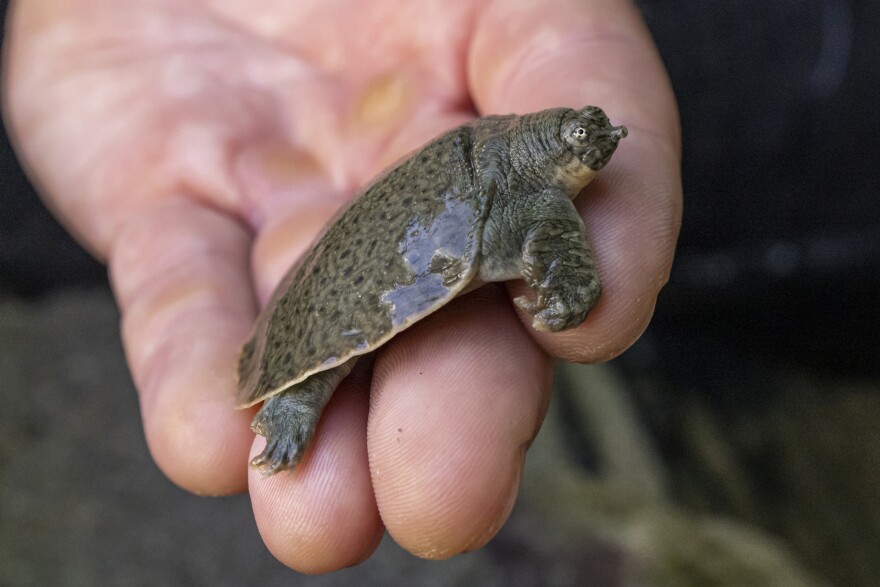San Diego Zoo Wildlife Alliance researchers are celebrating their first successful breeding of an endangered Indian narrow-headed softshell turtle.
The hatchlings are the product of a reproductive effort that was launched more than 20 years ago when the zoo acquired its first two female turtles in 1997. They added a male in 2000.
Wildlife Alliance herpetologist Kim Gray looks out over the Mesa Crocodile Habitat at the San Diego Zoo.
“This is basically a replica of what you might encounter in Asia. In the Indian sub-continent in particular,” Gray said.
The turtles typically hang out on a river bottom. They wait for prey to swim too close and then quickly extend their necks and snap them up.
“The mother of some of the offspring we have is in the sandy pool area,” Gray said. “She’s hidden underneath all of that sand. She’s using the camouflage to help hide her.”
The turtles are mostly flat with a leathery skin instead of a hard shell. And they are big.
“Very big,” Gray said. “When you’re down there next to them, it’s quite impressive but she’s about two and a half feet by about three and a half feet.”
The soft-shell turtles can grow to 440 lbs. As adults.
“This habitat area was designed with this species in mind,” Gray said. “Thinking in the future, we didn’t know when, but our goal was that they would breed one day. We didn’t know it would take so long. But we’re happy.”
A long time indeed.
“Just waiting and hoping,” Gray said.
San Diego researchers waited more than 20 years for the turtles to breed.
“You can anticipate it and hope for the best, but you’re always pleasantly surprised,” Gray said.
The magical event finally happened this summer, 25 years after the first two softshell turtles arrived here.
Keepers found a clutch of eggs in a crude nest on the habitat’s beach area and then they located several more.
Eventually they isolated 11 eggs to incubate. Then the surprise.
“The last time scientists really took all the wild data and determined what its status was, was 22 years ago,” Kim Gray said. “If it was endangered then, our concern is that it’s even worse now.”
Senior Wildlife Care Specialist Davis Provan saw tiny turtles in the habitat area. 30 more had hatched from a hidden nest in the habitat.
“Oh yeah, I got a text,” Gray said. “And we were celebrating a text at six o’clock in the morning or something and we were all texting each other. We were all excited.”
The baby turtles are currently living at an off-exhibit area.
“This is a hatchling, narrow headed softshell turtle,” said Provan as he handled one of the more active turtles.
It is about two inches long, a far cry from the more than 400 lb. turtle it will grow up to be.
“So for the first month or so they seem pretty determined to come up on land. And possibly bask,” Provan said. “After that point they’ll stay in the water, and they’ll stay buried under the sand as ambush predators and wait for small invertebrates to come by for them to pick off. So, we have these little, I think they are black worms in the water for them to learn how to eat.”
Part of the challenge now is finding homes for the hatchlings. While they are just a few inches long now, they will get much bigger. They need to find institutions capable of caring for them.
But for now, zoo staff are enjoying the long-awaited success.

“You can see, jokingly, it does have a turtleneck,” Gray said. “It’s a turtle with a turtleneck. It’s almost like a fabric, like a sweater turtleneck. And again, it's deceiving, the head looks quite small but the skull on these animals is quite impressive. They have a lot of muscular attachments for that powerful shoot-out of the neck.”
In the wild, the turtles are a marker species for the river habitats they occupy in Nepal and India. If the turtles are thriving their habitats are likely healthy.
But if those habitats are in trouble, the hatchlings could help preserve the species.
She hopes the hatchlings will teach conservationists how to help the species in the wild.
“The last time scientists really took all the wild data and determined what its status was, was 22 years ago,” Gray said. “If it was endangered then, our concern is that it’s even worse now.”
San Diego researchers are recording everything. Weight, activity, diet, etc. They hope to learn as much as they can about the hatchlings because this is the first time these turtles have bred in captivity at an accredited facility in North America.
“We can help share with a plan that should we need to intervene more, maybe these head start or assurance colonies. That this (successful breeding) can help contribute to that,” Gray said.
-
After a state audit found the San Diego County Sheriff’s Department failed to adequately prevent and respond to the deaths of individuals in its custody, San Diego Assemblywoman Akilah Weber wrote the, “Saving Lives In Custody Act.” Governor Gavin Newsom vetoed the bill on Friday. Then, a sailor charged with intentionally setting the fire that destroyed the Navy ship the USS Bonhomme Richard was acquitted in a military court. Reporting by ProPublica uncovered systemic failures that contributed to the destruction of the $1.2 billion dollar warship.
-
California is experiencing the driest three years ever recorded and we’re on track for a fourth year. In other news, Tijuana gas stations are capitalizing on California’s record-high gas prices. Plus, the San Diego Zoo Wildlife Alliance is celebrating their first successful breeding of an endangered Indian narrow-headed soft-shell turtle.













